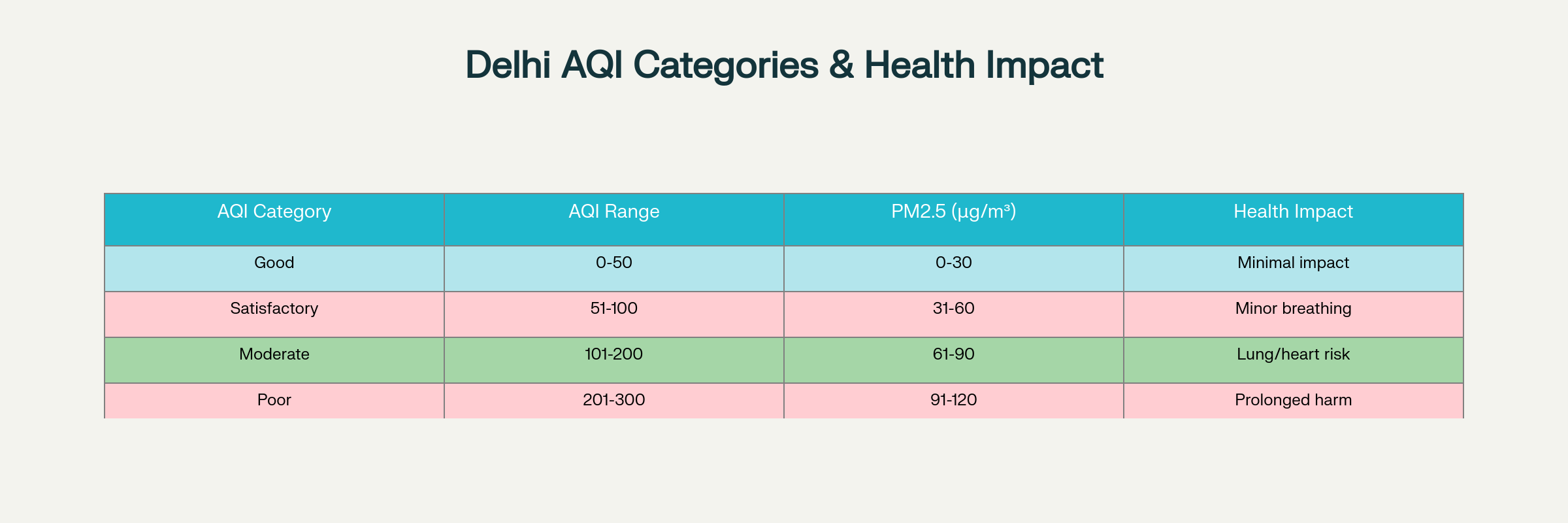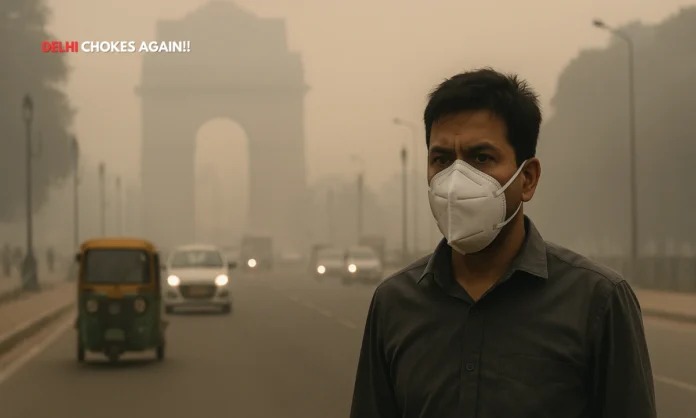Delhi AQI Crisis has reached alarming proportions as the air quality index soared to 367 on Friday morning, pushing the national capital into the “very poor” category just days before Diwali celebrations, as authorities activate emergency pollution control measures across the region.
Key Highlights
- Delhi AQI Crisis intensifies with readings at 367 at 8 AM Friday, with multiple areas showing dangerous levels above 200
- Stage-I of Graded Response Action Plan (GRAP) activated across Delhi-NCR as the Delhi AQI Crisis worsens ahead of Diwali weekend
- Supreme Court permits green crackers sales from October 18-21 with restricted timing, while Delhi prepares artificial rain trials to combat the Delhi AQI Crisis
Severe Air Quality Deterioration Grips National Capital
The Delhi AQI Crisis has reached unprecedented levels as the Air Quality Index soared to 367 on Friday morning, according to Central Pollution Control Board (CPCB) data, marking a significant deterioration in air quality just days before Diwali celebrations. The alarming reading places Delhi firmly in the “very poor” category, where respiratory illness can develop with prolonged exposure, affecting both healthy individuals and those with pre-existing conditions during this AQI Crisis.
Multiple monitoring stations across the capital recorded concerning levels, with Anand Vihar showing 276, Bawana at 367, Chandni Chowk at 310, and Dwarka Sector 8 registering 305, indicating widespread pollution across different areas of the city amid the ongoing Delhi AQI Crisis. The deteriorating air quality represents a stark reminder of Delhi’s annual winter pollution emergency, which typically intensifies during the festival season due to multiple contributing factors including meteorological conditions and increased particulate matter emissions that fuel the Delhi AQI Crisis.
Delhi NCR be ready to welcome the pollution season in this year as well.
— Dinesh Thakur (@DineshSEM) October 11, 2025
500+ AQI is loading.
Festive season is temporary, pollution season is permanent.
Im pretty sure govt plan is to make us breathe in polluted air for next 1-2 months. pic.twitter.com/LtBxsBIGlP
Emergency Pollution Control Measures Activated Across Delhi-NCR
The Commission for Air Quality Management (CAQM) has implemented Stage-I of the Graded Response Action Plan (GRAP) across the entire National Capital Region following the escalating Delhi AQI Crisis, with readings dropping to 211 on Tuesday and continuing to worsen throughout the week. Under Stage-I restrictions designed to address the Delhi AQI Crisis, 27 preventive actions are now being strictly enforced by all relevant agencies, including deployment of anti-smog guns, intensive water sprinkling, and enhanced dust suppression measures in construction and road maintenance activities.
The Delhi government has simultaneously unveiled its comprehensive 25-point Winter Action Plan to combat the Delhi AQI Crisis, mobilizing 86 mechanical road sweepers, 300 water sprinklers, and 362 anti-smog guns across the capital to reduce pollution levels. Additionally, 578 enforcement teams have been deployed specifically to monitor vehicular emissions as part of the response to the Delhi AQI Crisis, while six new air quality monitoring stations are planned to be operational by March 2026 as part of the expanded surveillance network. These measures represent the government’s proactive approach to preventing further deterioration during the Delhi AQI Crisis, recognizing that the critical winter months ahead will require sustained intervention when meteorological conditions typically worsen pollution levels.
Supreme Court Permits Controlled Green Cracker Usage During Diwali
The Supreme Court of India has granted permission for the sale and use of green crackers across Delhi-NCR from October 18-21, acknowledging the cultural significance of Diwali while attempting to minimize the impact on the ongoing Delhi AQI Crisis. Chief Justice BR Gavai’s bench established specific timeframes limiting firecracker usage to 6 AM-7 AM and 6 PM-10 PM during these designated days, recognizing that uncontrolled celebrations could severely worsen the Delhi AQI Crisis. The court’s decision represents a balanced approach to festival celebrations while acknowledging air quality concerns, noting that complete prohibition has proven ineffective as regular crackers are often smuggled into the region from outside areas, potentially exacerbating the Delhi AQI Crisis.
Green crackers, designed to produce reduced emissions compared to conventional fireworks, must display QR codes that will be uploaded to official websites for verification, with manufacturers facing license cancellation if found producing fake green crackers during this sensitive period of the Delhi AQI Crisis. The Central Pollution Control Board and State Pollution Control Boards have been directed to closely monitor air quality levels from October 18 and submit detailed reports to the Supreme Court regarding changes during the permitted period and their impact on the Delhi AQI Crisis.
Innovative Artificial Rain Technology Prepared for Post-Diwali Implementation
Delhi stands ready to deploy India’s first urban cloud seeding program immediately after Diwali as an innovative solution to address the Delhi AQI Crisis, with the Directorate General of Civil Aviation (DGCA) approving trials using a specially modified Cessna-206H aircraft operated by IIT Kanpur between October 1 and November 30. The innovative weather modification technique involves releasing silver iodide compounds into moisture-laden nimbostratus clouds situated between 500-6,000 meters altitude, requiring at least 50% moisture content for optimal effectiveness in combating the Delhi AQI Crisis.
Environment Minister Manjinder Singh Sirsa confirmed that four successful trial flights have already been completed, with the aircraft remaining on standby pending favorable meteorological conditions and final clearance from the India Meteorological Department to intervene in the Delhi AQI Crisis. Scientific projections suggest that successful artificial rain could improve Delhi’s Air Quality Index by 50-80 points, potentially shifting air quality from “very poor” to “poor” or “moderate” levels, offering hope for relief from the Delhi AQI Crisis, though effectiveness depends on rainfall intensity, wind speed, and coverage area. This groundbreaking initiative represents Delhi’s commitment to exploring innovative technological solutions for urban pollution management and addressing the Delhi AQI Crisis, marking a significant step in India’s environmental protection efforts.

Delhi Air Quality Index Categories and Health Impact Guidelines
Health Impact and Regional Air Quality Concerns Intensify
The current Delhi AQI Crisis poses severe health risks across the Delhi-NCR region, with official CPCB guidelines indicating that “very poor” air quality levels cause respiratory illness on prolonged exposure and significantly impact individuals with pre-existing health conditions. According to World Health Organization data, Delhi consistently ranks among the world’s most polluted capitals during episodes like the current Delhi AQI Crisis, with PM2.5 concentrations nearly 10 times higher than recommended levels, contributing to an estimated 10,000 premature deaths annually in the region.
The broader National Capital Region shows equally concerning trends amid the Delhi AQI Crisis, with Ghaziabad recording a “very poor” reading of 307, Noida at 288, and Greater Noida at 272, indicating that the pollution emergency extends well beyond Delhi’s administrative boundaries. Research published in 2025 reveals that poor air quality has irreversibly damaged the lungs of 2.2 million children in Delhi, while India’s Ministry of Earth Sciences attributes 41% of air pollution to vehicular emissions, 21.5% to dust, and 18% to industrial sources contributing to the Delhi AQI Crisis.
The timing of this air quality deterioration coincides with unfavorable meteorological conditions, including reduced wind speeds and potential morning mist formation, which typically trap pollutants closer to ground level during winter months and intensify the Delhi AQI Crisis.
Closing Assessment
The Delhi AQI Crisis intensifies as the capital approaches Diwali weekend, with air quality levels exceeding 350 and comprehensive emergency measures now in effect across the National Capital Region. The convergence of seasonal meteorological factors, upcoming festival celebrations, and persistent pollution sources creates a critical period requiring sustained implementation of both traditional control measures and innovative solutions like artificial rain technology to address the Delhi AQI Crisis.
While the Supreme Court’s balanced approach to green crackers acknowledges cultural significance, the success of pollution mitigation efforts during this Delhi AQI Crisis will depend on strict enforcement of GRAP measures and public cooperation in following environmental guidelines during this challenging period. The capital’s readiness to deploy cloud seeding technology represents a forward-thinking approach to urban environmental challenges, though immediate relief from the Delhi AQI Crisis relies on effective implementation of existing pollution control strategies and favorable weather conditions in the coming days.


